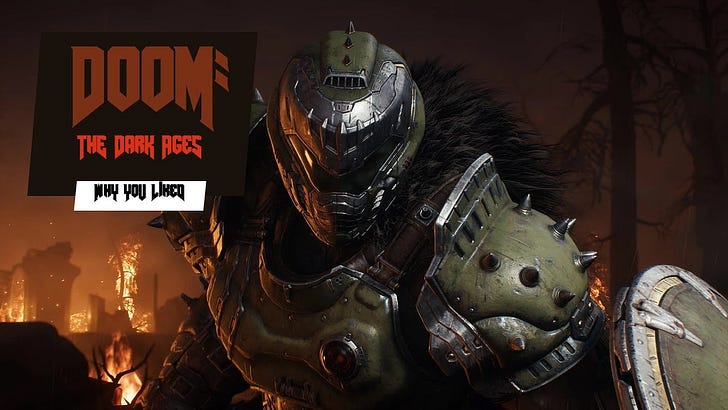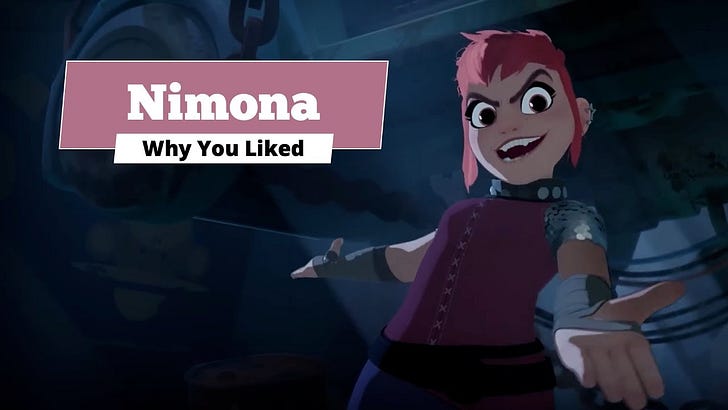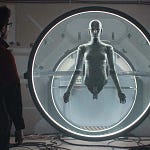I haven’t had this much fun with a shooter since… well, ever. Doom: The Dark Ages isn’t just more Doom. It’s the best Doom’s ever been. That said, I didn’t love it for the story.
Or… did I?
By the end of this piece, you’ll know why Doom: The Dark Ages deserves to be called a masterpiece: it revives Doom’s core and evolves it into something surprisingly thoughtful. I liked it more than 2016’s rebooted Doom, which I once pegged as the series’ peak.
You might think an allegedly story-free game is an odd thing for a channel that loves stories to focus on, but hear me out. A lot of people think “story” is the same as “plot.” The real calculus is:
STORY = PLOT + CHARACTER
We’ll get back to this, but for now, remember: stories don’t live without people in them, no matter how cool the series of events is. The Dark Ages’ plot is more or less a hot mess designed to powerslide you through each level, but it does some unexpected character work that earns a second glance. Let’s start where it all began: with a big fucking gun.
All the Feels
The BFG makes a return in Doom: The Dark Ages, but what that acronym stands for is both wonderful and a spoiler, so you’ll have to discover it for yourself. What I can get into is The Dark Ages’ core gameplay loop, which I’ll describe in two words: primal and perfect. You walk into a demon-infested cathedral, your shield’s already out, and seconds later the place is a Jackson Pollock painting in red.
The original Doom, a Christmas gift to the world back in 1993, was unapologetically a story of its time. It was a game that didn’t drift from Doom Slayer doing what he did best: killing demons in bulk, probably because he got a volume discount on ammo. The Dark Ages is a game that doesn’t shy away from its origin’s roots, but is a refinement in both gameplay and story.
The devs suggested this outing would feel more like being an armoured tank rather than a zipline champion, but I didn’t think it was slower Doom. It’s smarter Doom. It lets you decide how to rip and tear. Every gun roars. I had my favourites, but nothing felt useless. If I ran dry on Ol’ Faithful, I could pull out his bastard child and continue mowing down demons. It’s like ice cream: the king of flavours is obviously cookies and cream, but I won’t send French vanilla back to the kitchen. It’s still ice cream, and in The Dark Ages, never has demon-slaying tasted so good.
That Thicc Aesthetic
If 2016’s Doom was Space Hell, this one is Cathedral of Rage. The vibe is Doom x Warhammer 40k x Darksiders: heavy, angry, metal-as-hell art design that makes every level feel like you’re trespassing in Joe Madureira’s brain. Its emphasis is on brutalist fantasy, not space-age tech.
The game drips with gothic, medieval techno-weirdness. It’s set back in time, but there are energy weapons. You’re going to Classic Hell, but then there are Cthulhu tentacle-faced monsters, like Lovecraft was 2UP on the writing team. There’s spacecraft, Gundam-ass mechs, high-velocity kinetic guns, energy weapons, and a big-ass ancient flail in your back pocket.
There’s no Halo-style clean sci-fi here. There’s no green-armoured Space Dad saving the galaxy. It’s Doom Slayer as a knight with a grudge against Hell, and the biceps to do something about it. It’s such a delightful mash-up of genres that shouldn’t work but absolutely does. It feels like the core design principle was, “If it’s cool as Hell, put it in.”
Soundtrack, Sound Design, and Performance
On an AMD Ryzen 7700X with an NVIDIA 4070 Super, the game ran flawlessly, no stutter, no drops, on Ultra Nightmare settings (with DLSS upscaling and frame generation). Take a side quest to Digital Foundry if you’re the kind of nerd who loves tech stuff; they cover it in more depth, but I found the dynamic resolution invisible. The visual fidelity holds up even during the biggest bloodbaths.
Music needs an acknowledgement. Mick Gordon came in for the music on 2016’s Doom and its sequel, Doom: Eternal, and it was metal as hell. Mick didn’t come back for The Dark Ages due to a nuclear-level event between him and id Software’s executive producer, Marty Stratton. This means the soundtrack here was put together by Finishing Move Inc., who’ve done work on games like Borderlands and The Callisto Protocol.
I think trying to follow Mick Gordon is a difficult job, and it’s unfair to both parties to compare them. I will say that Finishing Move made a soundtrack that’s spiritually Doom; it’s metal. If you like metal, you’ll be headbanging by the second level. If you don’t like metal, it’ll still get the job done in the background, making you feel like a demonic gladiator. And what more does any Doom Slayer need?
Positional audio is a treat in this. With a set of Atmos cans, there’s a next level of fidelity added to the experience. If you can, go surround; no demon will get a cheap shot in.
Who Wore It Best? Representation Done Right
While The Dark Ages channels its gory roots, it takes a quick left turn from the standard chainmail bikinis popular in the 90s. The game’s supporting cast includes Commander Thira, Princess of Argent D’Nur, and daughter of King Novik.
She’s not your average female sidekick. She’s sensibly dressed in armour and plot relevance. It’s her dad that’s the shirtless one: Novik struts around, abs out, dual pauldrons, and zero shame. The flip feels deliberate: the chainmail bikini energy goes to the bloke.
Let’s linger on this for a moment, because it’s one of the smartest costume subversions I’ve seen in a dudebro shooter. Our heroine, Thira, is armoured. Practical. No boob window or weapons-grade cleavage. Just solid gear that says “I’m here to fight demons, not to become a collectible statue.” Meanwhile… it’s her dad that’s decked out like he lost a bet. If she’s dressed for war, he’s dressed for a Pinterest board titled, “Barbarian thirst traps.”
Doom: The Dark Ages tosses the trope away. It plays into a bigger point: Thira’s not someone you rescue because she’s a woman. She’s someone the demons go after because she’s dangerous. This is important: we’re getting to story stuff. With games still dredging out the rescue-the-maiden gig, Thira’s the character who’s targeted by the bad guys because she has agency.
It’s a critical point in the evolution of who gets to matter.
In the Classic Era™ (1993-2004), Doom Slayer was an angry Marine. Male-coded, yes, but more an avatar of fury than a character. I remember no women in the original games. Representation didn’t exist as a design goal. The focus was purely gameplay: speed, gore, and fun. The “narrative” was a few screens of text between levels, which you read out of guilt for skipping every cutscene in Wing Commander.
It wasn’t anti-representation, but it was definitely pre-representation-as-conscious-design.
For the Reboot Era™ (Doom 2016 and beyond), the cast is mostly corporate white dudes, demons, and one (eventual) robot (Samuel Hayden). There’s Dr. Olivia Pierce (the main villain), which is a big swing for a female antagonist in the FPS genre. She’s ambitious, arrogant, and not sexualised, but she’s also a cautionary tale: the woman who reached too far, too fast.
Thira in The Dark Ages is a notable pivot:
She’s not sidelined or reduced.
She’s not a romance object.
She’s an ally, and her moral stance matters.
And her costume reflects respect, not fan service. Her dad being the eye-candy barbarian is both funny and subversive, especially in a genre that usually gives us impractically battle-thonged sorceresses.
This signals a maturity in Doom design: not just including women, but deconstructing the way they’re usually portrayed. Doom: The Dark Ages didn’t just give us a woman in armour. It gave us a woman with agency, and a dad who forgot his shirt. It’s funny, sure, but it also makes a quiet, confident statement: in this world, strength isn’t about gender, it’s about what you do when consequences are literally about the world becoming Hell on Earth.
Story = Character + Plot (and Doom Finally Gets It)
Classic Doom had a plot, not a story. Doom Slayer was a rage avatar. Your dude is angry, pixellated, and just keeps moving. The plot was a justification for gameplay: “Demons come through a portal. You’re here. Do something about it.” It’s silent on character development.
2016’s Doom switched this up but remained plot-heavy and character-light. The plot is: you wake up, find Mars is on fire, and get briefed by a robot. The character work is mostly Doom Slayer using his body language, not his words, showing an abject disdain for exposition. His entire arc is summed up by the intro where he busts a monitor mid-explanation. The message is clear: don’t expect nuance here. While Hayden and Pierce get the most character depth, the protagonist remains stoic, sure, but mostly symbolic.
The big switch is not that The Dark Ages delivers a plot that rivals War and Peace. It remains simple: demons are bad, and something something betrayal. But Doom Slayer now has relationships. They’re not dialogue-heavy, because Brother Doom Slayer is too busy getting the job done. That doesn’t mean they’re less meaningful. The game opens with Doom Slayer under the yoke of Kreed Maykr. In the war against Hell, Doom Slayer is the ultimate weapon, but controlled by a device. Thira thinks this is total shit, and she has Doom Slayer’s back, giving him the eventual method to free himself.
Doom Slayer now has an arc. It contains small moments of reflection. Who he respects. Why he shows restraint. And what his response is to betrayal. The world around him feels more aware of Doom Slayer through the actions of characters like Thira. See, she stands up for him. Thira risks their greatest weapon in the war on Hell because otherwise, what’s the point? You have to win against evil with good, not with more evil.
That’s what means she matters. Doom Slayer isn’t just killing demons because he’s angry, although to misquote Ghostbusters, Slaying Makes Him Feel Good. He’s killing because people betrayed him while others risked everything to back him. Doom: The Dark Ages proves you can have blood-slick action and emotional weight. The emotion hits harder because it’s rare and earned.
Don’t even get me started on the dragon. If you know, you know, and I still can’t talk about it.
The Bug That Cursed Me
Even masterpieces can catch a few stray bullets.
While The Dark Ages ran pretty well, that doesn’t mean it was flawless. I hit a bug on three separate levels where terrain-locked enemies meant I couldn’t complete some encounters. This can block upgrades and collectables. I can live without the power-ups; by the end you’re dripping in sweet epic cannons. But I wanted that glorious 100% completion across all levels, and that door stayed locked tighter than your expected tax rebate.
I’ve found it mentioned elsewhere as a known bug, but this is what stopped me going back for a second playthrough immediately. I want that subsequent trip through Hell to feel like Heaven, not a journey through Glitchville.
But, yes: I rolled credits and, despite the bug, immediately wanted to jump back in. Despite the main campaign clocking in at 20 hours for my first run, I wanted to do it all over again.
The Final Verdict
This is a game that makes you want to complete it. If you’re here for an overly rich narrative or delicate pacing, this ain’t your jam. But if you like making demons into jam, you’re going to have a hell of a good time. It’s still a murder-symphony in demon guts, but now it’s got a theme. It’s not just more Doom. It’s better Doom. And, crucially, it lands the critical marriage of plot and character driving a genuine story.
Doom: The Dark Ages isn’t slower. It’s smarter, meaner, and more satisfying than anything the franchise has done before. It’s a masterpiece, not because it’ll win some awards, but because it’ll win your Friday night. In a world of overlong tutorials and moral grey zones, sometimes it’s refreshing to just put on your helmet, grab your flail, and do the right thing the hard way.
Doom: The Dark Ages proves that even a demon-slaying power fantasy can grow up a little. In the end, the best stories aren’t just cool events. They’re what happens when character meets purpose. Doom Slayer’s finally got both.














